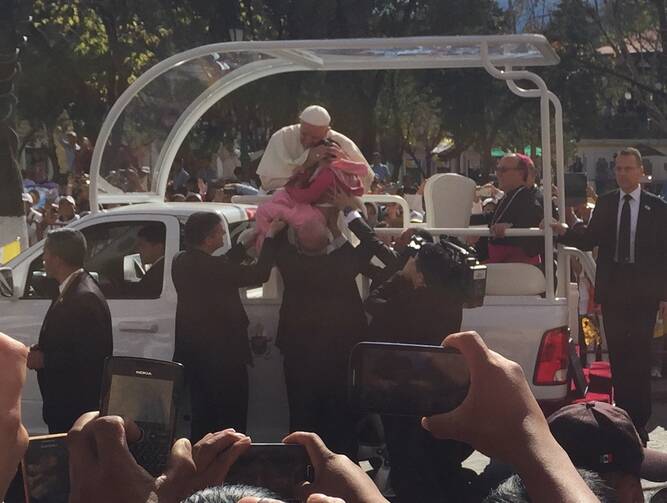They came down from the mountains surrounding the city; they came from faraway villages in other parts of Mexico and Guatemala. They came by bus, by car and taxi; they walked into town on their own two feet.
They came and waited overnight in the cold and then in the morning under a punishing sun. Those thousands who were turned away from the Mass itself waited for hours alongside the roads; they waited pressing against metal barricades surrounding the zocalo, crowding around the cathedral nearby for tiny precarious vantage points; they waited with ailing children for a hoped-for moment of Francis’ touch.
It is hard to overestimate the impact of the spectacle this morning and afternoon of Pope Francis visiting a community like San Cristóbal de las Casas in Chiapas, Mexico. Just a few months after visiting with the most powerful people in the world, he has come to the ends of Mexico to meet with the perhaps most marginalized people in Mexican society—the indigenous communities here have been denied their land, denied their culture and denied their languages—often by the church itself. But Francis came here today as our “hermano,” our brother, as pockets among the crowd chanted. The people here in this poor community have embraced him as he passed. He has spoken to them.
Just as they did in New York Philadelphia and Washington, where the world's most affluent people lined the streets to catch a glimpse of Francis, today in this small community in Chiapas, some of the world's poorest also waited for hours to catch a glimpse as Francis drove by. The smiles on the faces of those who saw him said the long wait had been worth it.
For one small family who managed their way through the crowd at the urging of others around them, desperate hopes were realized with great bounty. A small disabled girl, pushed to the front of the press first by her mother and father and then by everyone around them who saw what they were trying to do, was finally lifted over the metal barricade and brought out into the square before the cathedral, her parents following closely behind her.
As Pope Francis drew near the people around the little girl called out to him and gestured to the girl. Their hopes were not disappointed as the popemobile slowed to a stop and a little girl in pink was lifted from her wheelchair and brought to the pope. He embraced and blessed her as the crowd roared in approval.
Just a few hours before the pope had told the indigenous who had gathered to celebrate Mass with him in the city’s stadium, "Some have considered your values, culture and traditions to be inferior. Others, intoxicated by power, money and market trends, have stolen your lands or contaminated them.” The pope spoke powerfully against the destructive exploitation of creation, a tender subject in this state where mining or other powerful interests are giving priority over the claims and desires of the indigenous communities in land and use disputes.
"You have much to teach us," Pope Francis simply said. “Your peoples, as the bishops of Latin America have recognized, know how to interact harmoniously with nature, which they respect as a “source of food, a common home and an altar of human sharing” (Aparecida, 472).
But beyond these expression of support and hope was the powerful fact that Pope Francis choose to speak some of them in the languages of the indigenous themselves.
“Li smantal Kajvaltike toj lek,” Pope Francis, beginning his homily in Tzotzil; “The law of the Lord is perfect; it revives the soul. Thus begins the psalm we have just heard. … This is the law which the people of Israel received from the hand of Moses, a law that would help the People of God to live in the freedom to which they were called. A law intended to be a light for the journey and to accompany the pilgrimage of his people,” he said.
“A people who experienced slavery and the Pharaoh’s tyranny, who endured suffering and oppression to the point where God said, ‘Enough! No more! I have seen their affliction, I have heard their cry, I know their sufferings’” (cf. Ex 3:9).
His presence in this city today was a message to the indigenous communities here: Pope Francis has heard of your suffering and he has said, “Enough.”
In 2014, Pope Francis revived, after a 12-year suspension, a controversial policy allowing the diocese to start ordaining permanent deacons again. The majority of the diocese's more than 300 permanent deacons are married leaders in their indigenous communities; a policy that had first been adopted by Bishop Samuel Ruiz Garcia. Many had worried that the late Bishop Ruiz’s program of pastoral outreach had effectively exaggerated the place of indigenous culture in the local church and could be construed as a potential first step toward allowing married priests for indigenous communities. Pope Francis today also conveyed the Vatican's official approval of the use of the local languages in liturgical prayer.
But what most people will remember here after his remarkable visit will be the simple fact that the pope spoke in their language. Juan Santis Gómez, a parish and village leader who for hours had been crowded against a barricade by the cathedral with a large group from his community said, “He spoke Tzotzil, my maternal language.
"We felt very happy [hearing him speak Tzotzil] because we're indigenous, we're poor,” and this has been, he said “a moment of great support and hope for us."








